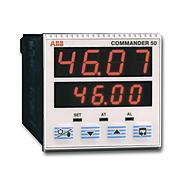AMAZON multi-meters discounts AMAZON oscilloscope discounts
Prior to the advent of electronic devices such as op amps and microprocessors, closed-loop controllers were originally designed to control pneumatic (air) signals because pneumatic signals were easy to adjust between a minimum and maximum signal. After the op amp was perfected during the 1960s, most closed-loop controllers were designed as dedicated single-circuit controllers that used operational amplifiers to compare the SP and the PV.
During the 1980s, inexpensive microprocessors became readily available, so newer controllers now use op amp and microprocessor technology together and the controller is completely programmable. ill. 1 (below) shows a picture of a type of single-point process controller, which usually has two windows where numbers and letters can be displayed to show the amount of the SP and PV. These controllers also have a simple keypad with arrows that allow numbers to be changed up or down as the operator scrolls through a series of menu choices to enter setpoint, alarm points, and other operational values.

PREV: Automating the Sump Pump Application
NEXT: Operating a Controller in Manual and Auto Modes